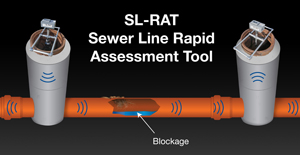New Sewer Inspection Technology Makes Itself Heard

























The Charlotte-Mecklenburg County, N.C., Utilities Division (CMUD) uses CCTV cameras to inspect its underground sanitary sewer pipes for blockages and interferences, but a new device that sends acoustical waves through sewer pipes is giving the utility a more accurate view.
“Often, the [CCTV] images were so dark and murky or the system would get hung up, and we couldn’t get a clear picture,” says John Fishburne, senior engineer in CMUD’s field operations division. “We wound up cleaning pipes that, in many cases, didn’t need it.”
In 2005, CMUD commissioned Ivan Howitt, an electrical-engineering professor at the University of North Carolina-Charlotte, to find a more practical way to assess and prioritize sewer-pipe maintenance. After a few dead ends, Howitt applied acoustical technology to the task and found that sound waves can accurately mimic the flow of water in pipe.
“If you have a reasonable expectation of what a clear pipe sounds like, transmitting an acoustical signal at one end and measuring its energy at the other will indicate whether something’s in the way,” says Howitt.
CMUD dubbed Howitt’s technology the Sewer-Line Rapid Assessment Tool (SL-RAT). Howitt commercialized the device and is selling it through his Charlotte-based company, InfoSense.
SL-RAT is “a lightweight, rugged device that provides a repeatable and reliable test and allows us to eliminate a lot of wasted resources,” says Fishburn.
The procedure works on 6- to 12-in.-dia pipes of any material. SL-RAT’s 18-lb transmitter and 11-lb receiver are designed to be deployed inside manholes 200 ft apart, but Howitt says it has achieved accurate results in 800-ft sections and longer. A brief transmission of a range of tones is usually enough to generate an acoustical profile at the receiver. The results can be read immediately or downloaded for subsequent analysis.
“Essentially, you’re yelling down the pipe,” Howitt says, adding that a two-person crew can perform the entire operation in three minutes. They can inspect up to 10,000 feet per day of pipe. “A crew using CCTV usually does, at most, 2,000 feet per day,” he says.
Howitt adds that SL-RAT is intended to rapidly assess whether there is a blockage and inform where CCTV should be used. Then, CCTV can go in and determine the exact nature of the blockage.
“If the SL-RAT’s results indicate blockage, you can then deploy CCTV to investigate the cause—roots, debris, grease, cracks and so forth—and what cleaning work may be necessary,” he says.









